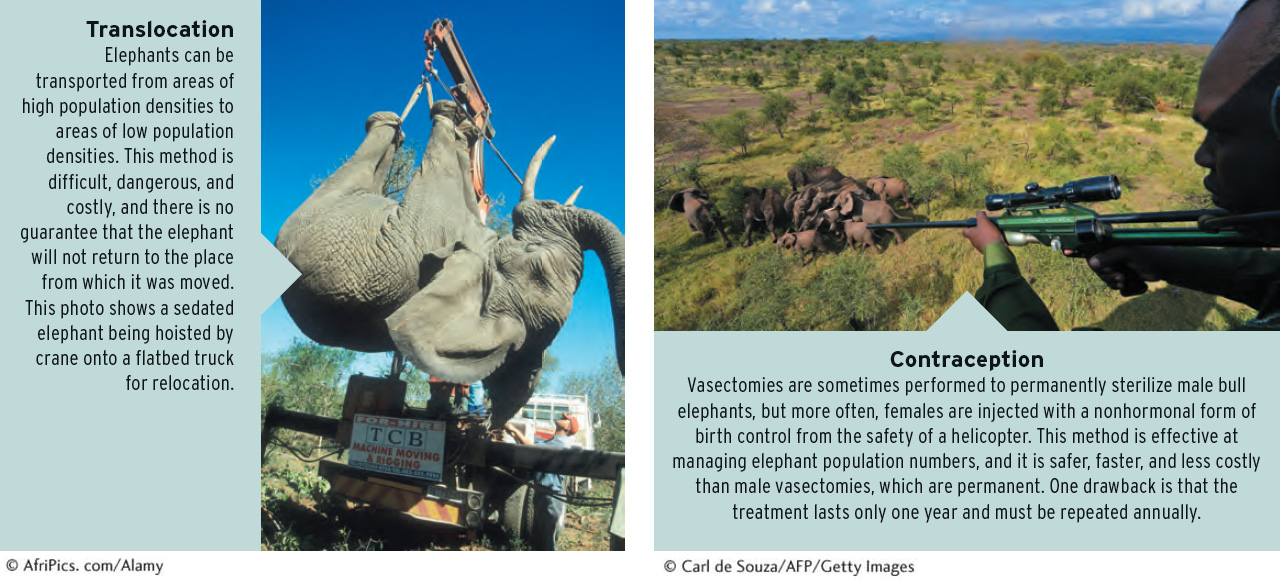8.2 Low-Latitude Biomes
Describe the major characteristics of low-
Low-
Tropical Rainforest
The tropical rainforest biome, found in the humid lowland tropics, has the highest primary productivity, the highest biomass, and the highest bio-
tropical rainforest
A forest biome in the humid lowland tropics; characterized by a multilayered forest structure and high biodiversity.
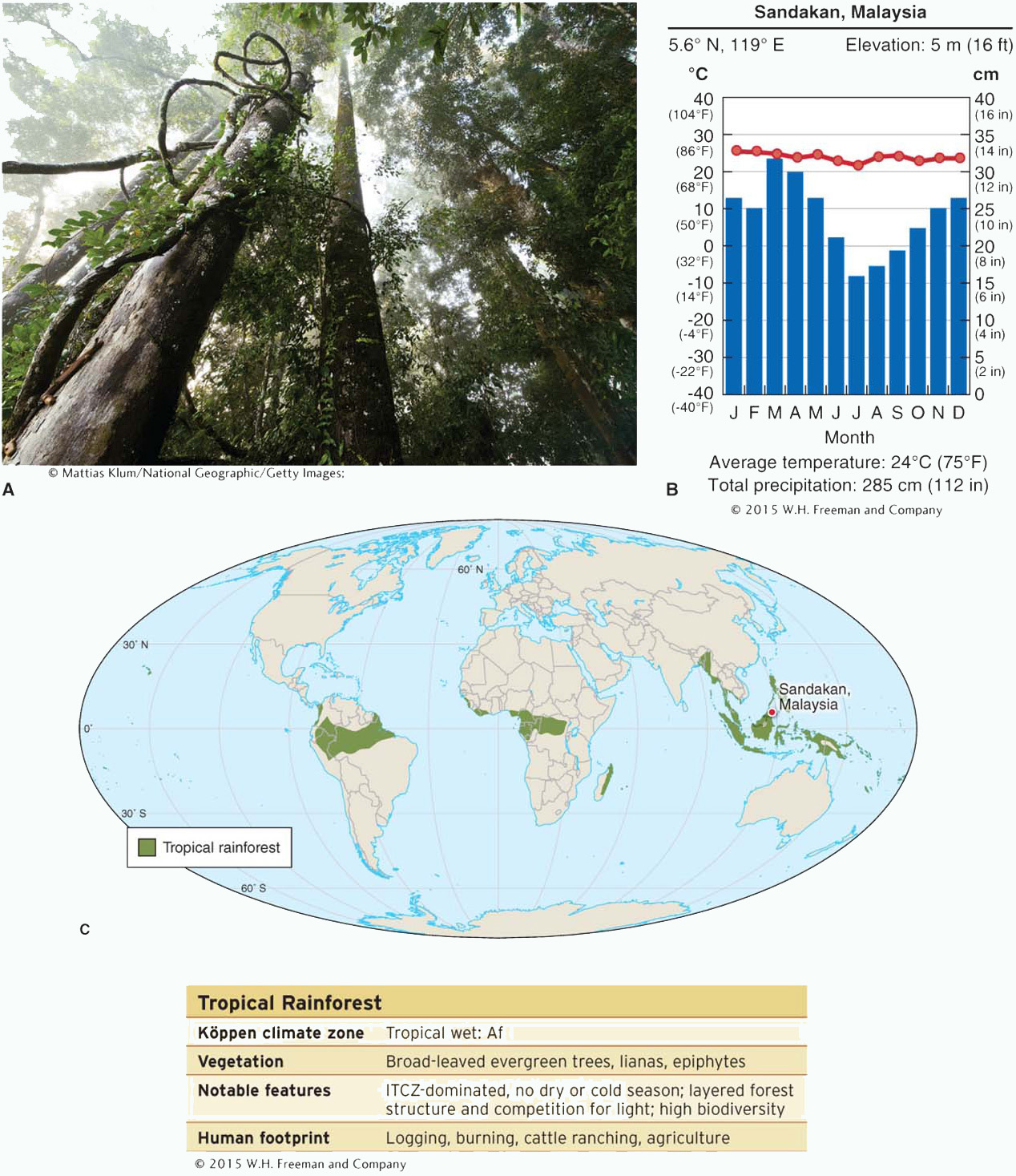
In the tropical rainforest biome, water is available in every month, and competition for light is a major limiting factor. As a result, the tropical rainforest biome develops a complex vertical structure. Its vegetation consists of multiple layers of broad-
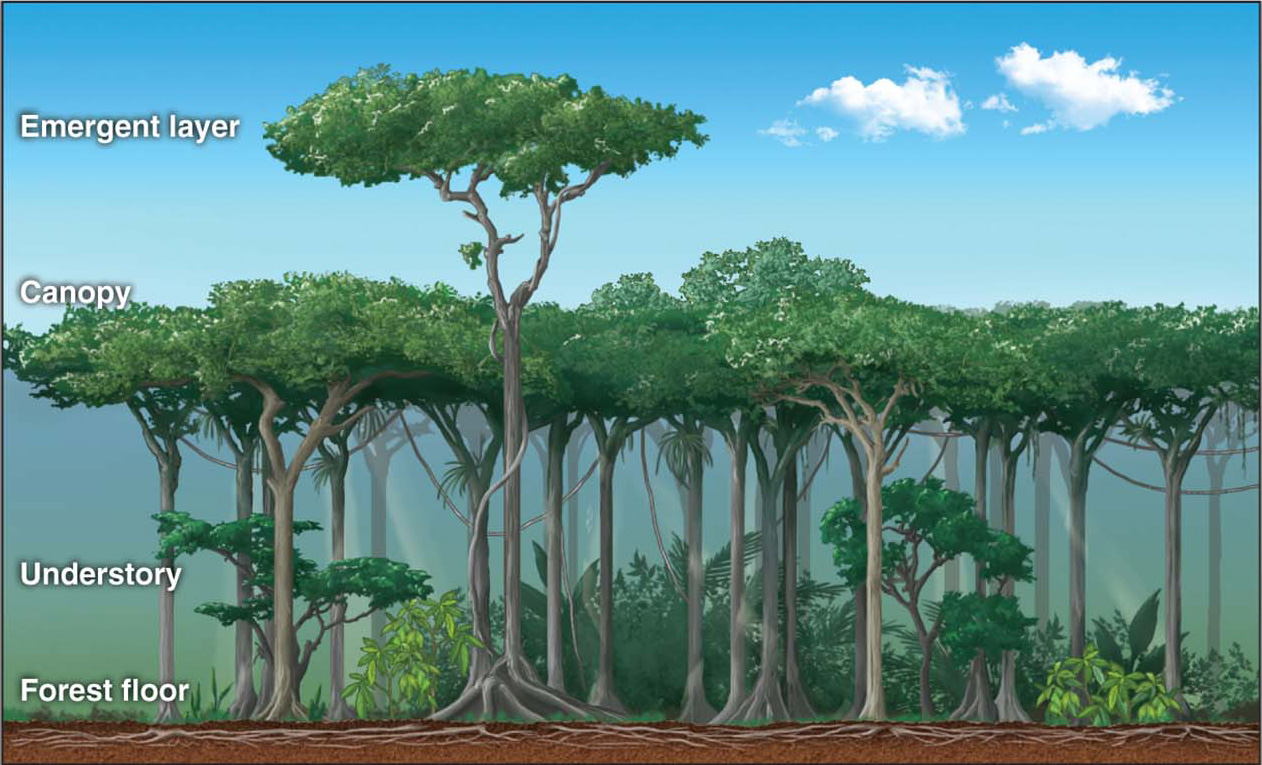
The strong vertical structure of the rainforest biome is driven by competition among the plants to reach sunlight. Many tropical rainforest trees have buttress roots to support tall growth to reach the light (Figure 8.6A). Lianas, which are woody climbing vines, are well adapted to tropical rainforest habitat. They grow quickly up trees to reach light in the canopy (see Figure 8.4A). Lianas also provide routes of travel for arboreal (tree-
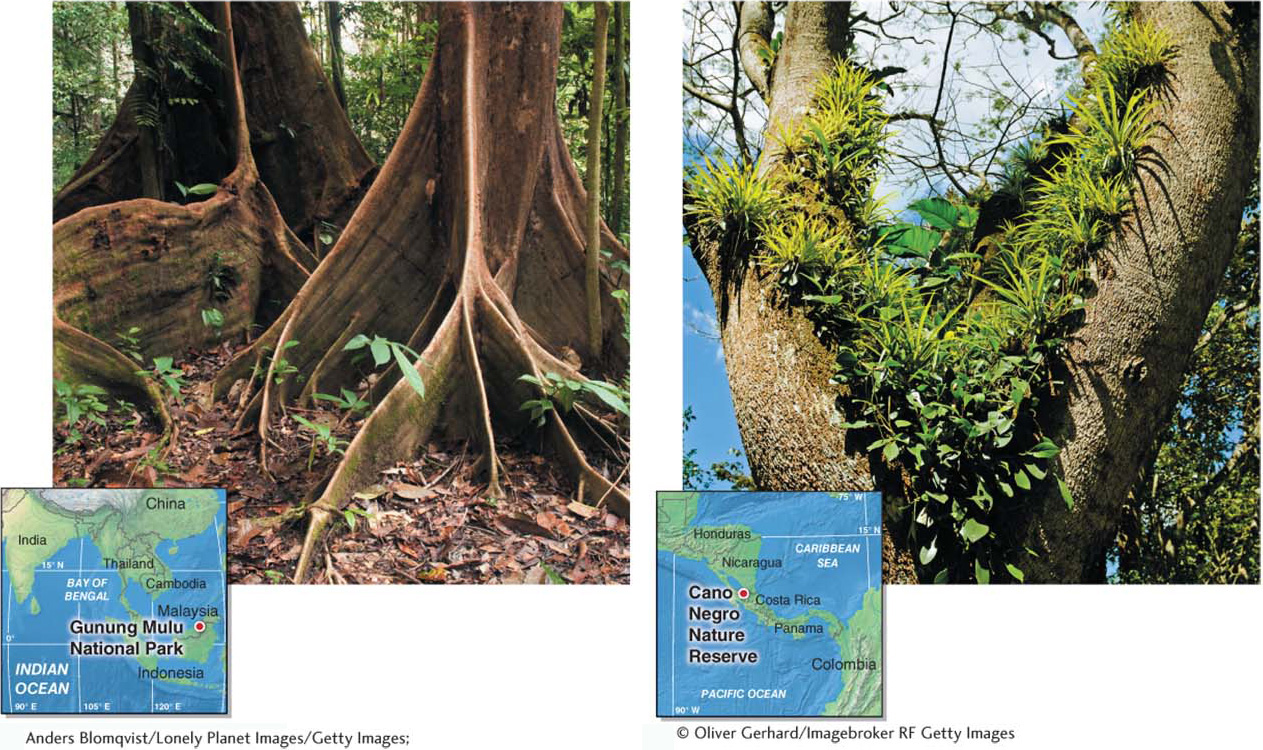
liana
A woody climbing vine.
epiphyte
A plant that grows on the surface of another plant but does not take nutrients from that plant.
The “crowded jungle” perception of the tropical rainforest is misleading. A walk through the shaded floor of a healthy tropical rainforest would be clear and unobstructed by plants in many places. Crowded plant growth occurs only where there are high light levels, such as in the canopy above, in light gaps created where large trees have fallen, or along stream banks.
Mutualism (see Section 7.2) between plants and animals is common in the tropical rainforest biome. At midlatitudes, many plants rely on the persistent westerlies (see Section 4.3) to disperse their pollen, seeds, and fruits. In contrast, equatorial tropical rainforests are dominated by the windless doldrums. Instead of the wind, bats, birds, fish, and mammals pollinate flowers and disperse seeds and fruit. Many tropical plants produce nutritious and brightly colored fruits and seeds to attract animal dispersers. In some tropical rainforests, up to 90% of plant species are pollinated by animals.
Picture This
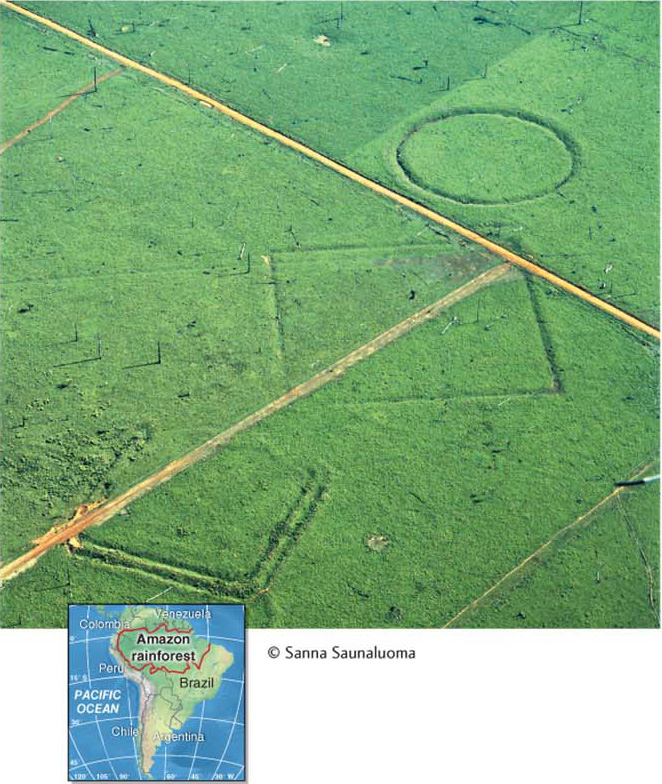
Lost Cities of the Amazon
More than 200 mysterious trench systems in the ground, called geoglyphs, have been found in recent years throughout the Amazon rainforest as trees have been cleared away. Many more are likely to be discovered as deforestation continues. The geoglyphs were built some 2,000 years ago, but it is not clear why they were built. They indicate that large permanent settlements, or “lost cities,” may have once existed in the rainforest.
Question 8.1
What are the “lost cities” of the Amazon?
The remains of trench systems and modified soils indicate that portions of the Amazon rainforest may have supported large human populations about 2,000 years ago.
Amazon rainforest soils are typically nutrient-
Consider This
Question 8.2
Is terra preta an anthropogenic soil? Explain.
Question 8.3
Do people modify soils today? If so, how?
Where there is volcanic activity, such as throughout Indonesia, tropical rainforest soils are young and nutrient-
Soils in the Amazon rainforest are particularly nutrient-
Human Footprint
Natural resources are like large bank accounts: Spend all the money in one shopping spree, and it disappears. Carefully manage it, live off the interest, and it can last generations. The same is true of rainforests and other natural resources.  Currently, undisturbed tropical rainforest is quickly being lost through deforestation. Figure 8.7 shows the typical sequence of events that cause deforestation in the Amazon rainforest. The important issue of habitat loss and fragmentation is further explored in the Geographic Perspectives at the end of this chapter.
Currently, undisturbed tropical rainforest is quickly being lost through deforestation. Figure 8.7 shows the typical sequence of events that cause deforestation in the Amazon rainforest. The important issue of habitat loss and fragmentation is further explored in the Geographic Perspectives at the end of this chapter.
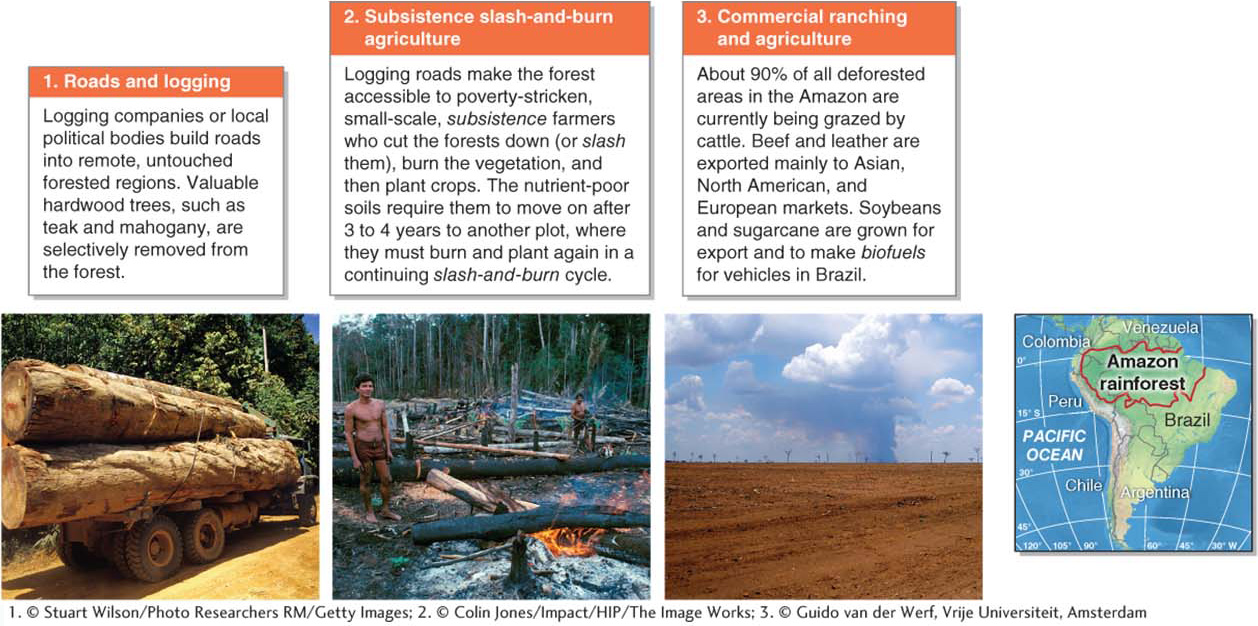
Each geographic region has unique factors that drive rainforest loss. While hardwood logging, cattle ranching, and soybean and sugarcane cultivation are driving rainforest loss in the Amazon, Indonesia is losing its rainforests to the production of palm oil. Picture This explores the Indonesian palm oil industry as a force of deforestation.
Picture This
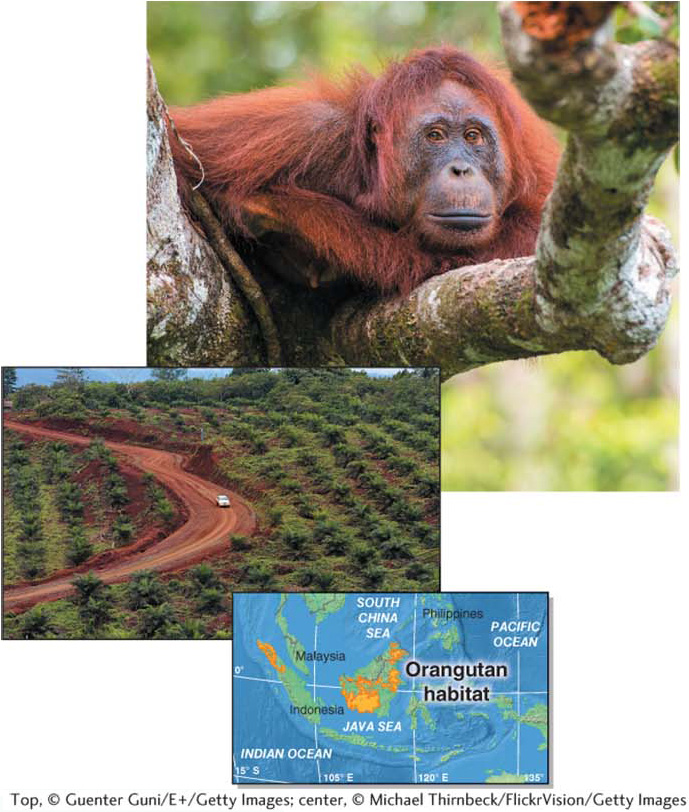
Orangutans and Palm Oil
Orangutans (Pongo pygmaeus and Pongo abelii) are among the most intelligent land animals, and they are one of the closest living relatives of humans. Their name comes from the Malay words orang hutan, which mean “man of the forest.” They live only in the rainforests of Sumatra and Borneo. They have lost over 80% of their original habitat, and their populations have been halved in the last few decades, dropping to about 60,000 individuals. If the current rates of deforestation continue, most scientists believe orangutans will be extinct in the wild within two decades.
Question 8.4
How can using biofuels harm Indonesia’s orangutans?
Orangutan rainforest habitat is cleared to make way for palm-
A new and powerful driver of deforestation and habitat loss has been the international demand for palm oil. About 85% of the world’s palm oil comes from Malaysia and Indonesia. Palm oil is made from the seeds of the African oil palm (Elaeis guineensis), which is grown on large plantations, often on cleared rainforest land (center photo). The tree is native to western Africa. Palm oil has a wide range of uses, from cosmetics to foods to lubricants and, increasingly, biofuels for cars and trucks. Palm oil is used in about 50% of the packaged products in a typical grocery store. It can be difficult to detect because it is often processed into palm-
Consider This
Question 8.5
How does the biodiversity of the original orangutan habitat compare with biodiversity of a palm-
oil plantation? Question 8.6
Trace the connection between the future of orangutans in the wild and a box of cookies in the grocery store.
The tropical rainforest biome is home to approximately 40% of all species on Earth. So this biome is central to efforts to estimate the global extinction rate. The global extinction rate is in large part a reflection of the rate of deforestation in this biome. A recent assessment published in Science in 2013 states that there are anywhere from 5 million to 8 million species worldwide. About 1% to 5% of those species are lost each decade, mostly because of habitat loss, and mostly in tropical rainforests. Crunch the Numbers asks you to use these figures to estimate about how many species are being lost each year.
Consumers of many of the products that are driving rainforest loss—
Tropical Seasonal Forest
The tropical seasonal forest biome is less well known than the tropical rainforest. In the summer wet season, it is often mistaken for tropical rainforest, but it is distinguished from that biome by its winter dry season. The tropical seasonal forest biome is found in the warm lowland tropics, where it borders tropical rainforest (Figure 8.8). The tropical seasonal forest is sometimes considered an ecotone (a transition between two biomes) for the tropical rainforest and the tropical savanna. Many trees in this biome are broad-
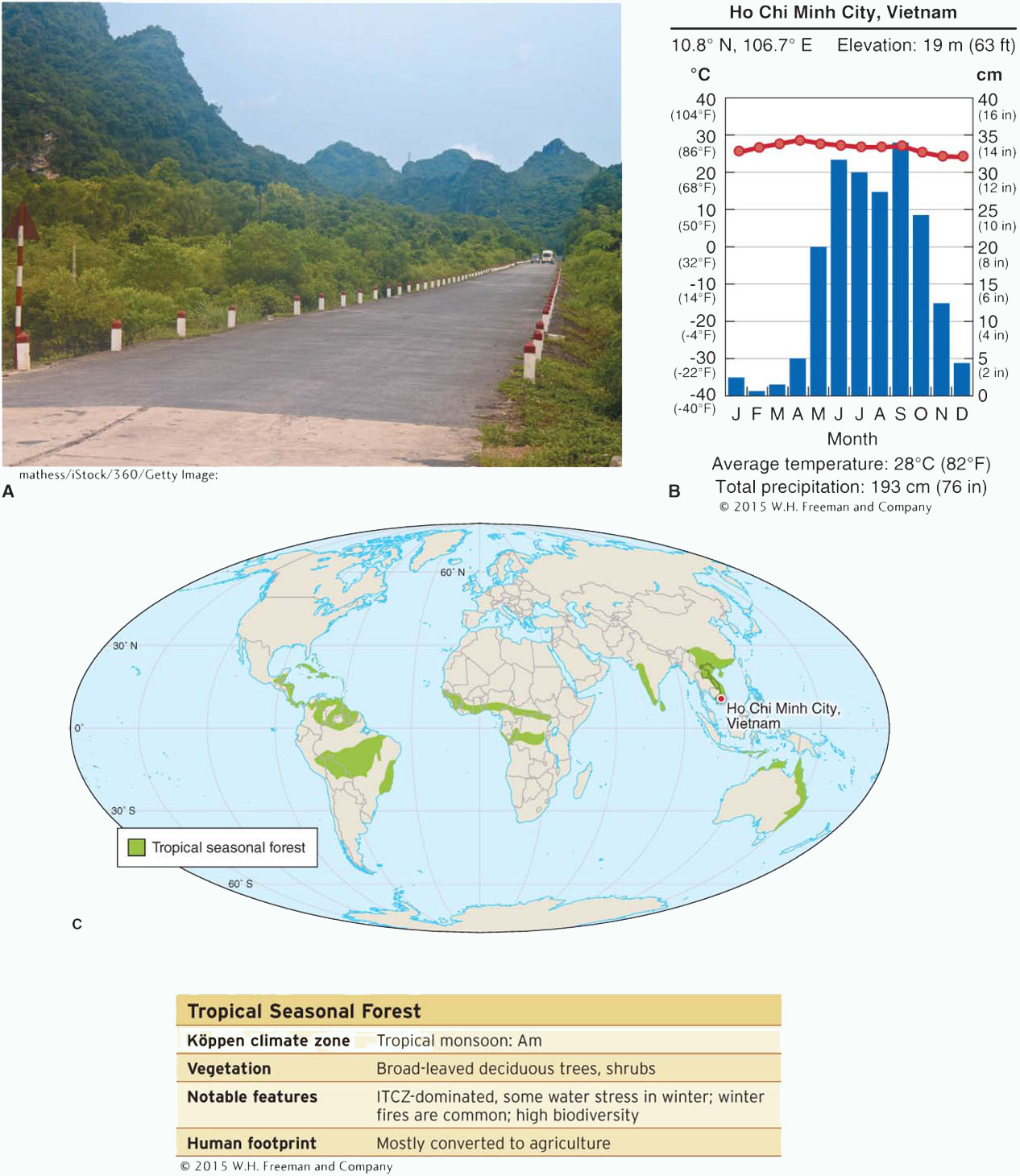
tropical seasonal forest
A biome in the warm lowland tropics, characterized by high biodiversity and trees that are deciduous in response to winter drought.
CRUNCH THE NUMBERS: Estimating the Global Rate of Species Extinction
CRUNCH THE NUMBERS: Estimating the Global Rate of Species Extinction
Assuming the global extinction rate is 3% of species per decade, calculate the range of annual species loss worldwide. First, assume that there are 5 million species. Then do the same calculation, but with the assumption there are 8 million species.
Question 8.7
Calculate species loss per decade by multiplying 3% by the estimated number of species.
Question 8.8
Divide your answer by 10 to get the annual rate of species loss.
The most distinctive characteristic that separates the tropical seasonal forest from the tropical rainforest is a dry season in the winter that lasts weeks to months. Throughout South Asia, summer precipitation in the tropical seasonal forest comes from the summer monsoon. There are only three dominant layers in most tropical seasonal forests: canopy, shrubs, and forest floor. The canopy is lower and more open than that of the tropical rainforest, so more light reaches the forest floor. The diversity of insects, birds, mammals, reptiles, and amphibians is, in many cases, nearly as high as that of the tropical rainforest.
Human Footprint
As a result of the dry season, the tropical seasonal forest is extremely vulnerable to fire. It is easy to burn the forest during the dry season. Increasing pressure from growing human populations, coupled with poverty, force people into the forest for subsistence farming. The soils of the tropical seasonal dry forest are better suited for crops and grazing than the soils of tropical rainforests.
Tropical Savanna
Tropical seasonal forest grades into tropical savanna, which is centered at about 25 degrees north and south latitude (Figure 8.9). Tropical savanna is characterized by wet summers and dry winters. Tropical savanna is a woodland biome, characterized by widely spaced trees with a continuous cover of grass. The winter dry period lasts much longer in tropical savanna than in tropical seasonal forest, as long as seven months in some locations. In the drier portions of tropical savanna, where the winter dry season lasts for six months or more, a type of tropical savanna called thorn woodland is found. In thorn woodland, the vegetation is dominated by shrubs and small trees that are tough and thorny. This growth form is a response to frequent fires, grazing by animals, and prolonged drought.
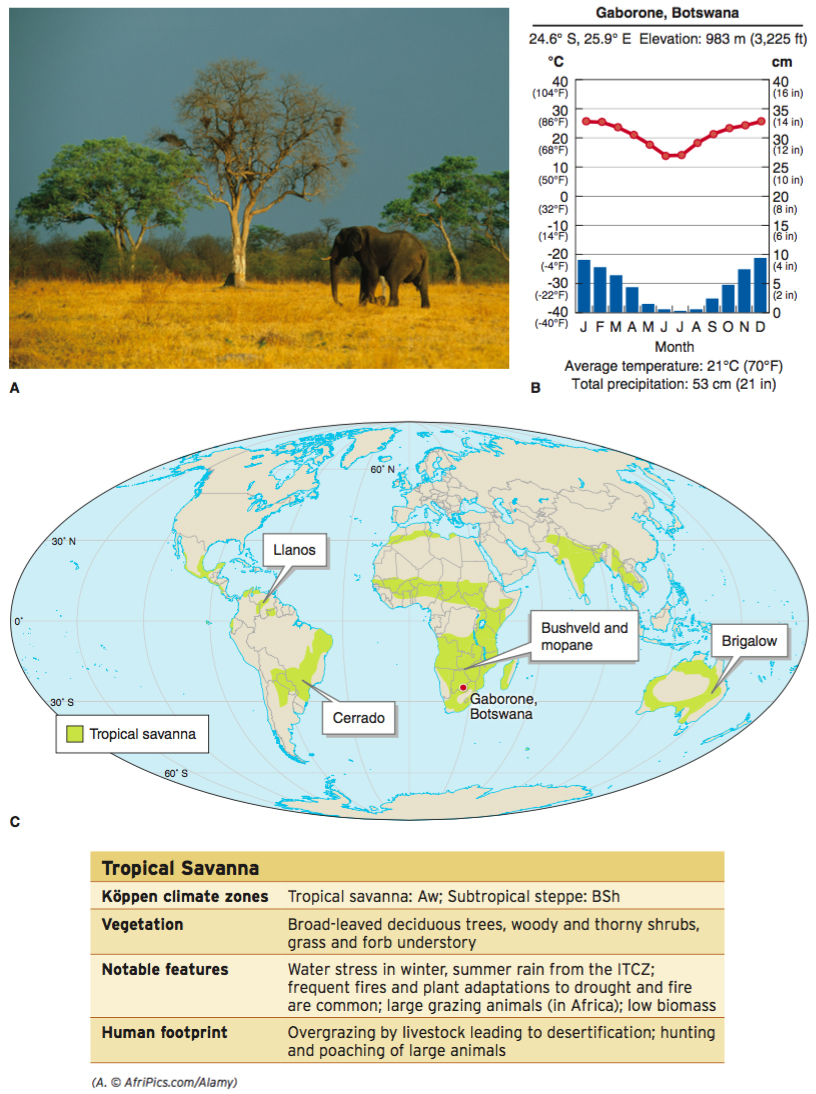
tropical savanna
A woodland biome with a wet summer and dry winter climate pattern, characterized by widely spaced trees with a grass understory.
The tropical savanna has low biomass and low biodiversity. Three factors strongly influence its vegetation structure:
Seasonally intense rainfall: The rainfall arrives with the ITCZ in summer, all within a few months, and often as intense thunderstorms. Deciduous plants grow during the rainy season and go dormant during the dry season.
Fire: During the warm winter dry season, abundant fuel and dry conditions favor frequent fires. Many savanna plants are adapted to survive fires.
Grazing pressure: More than 90 species of grazing ungulates (hoofed mammals) roam the African tropical savanna. Although the tropical savanna has low overall biomass, it is able to support the world’s largest and densest grazing animal community because the animals do not all graze at the same time (Figure 8.10).
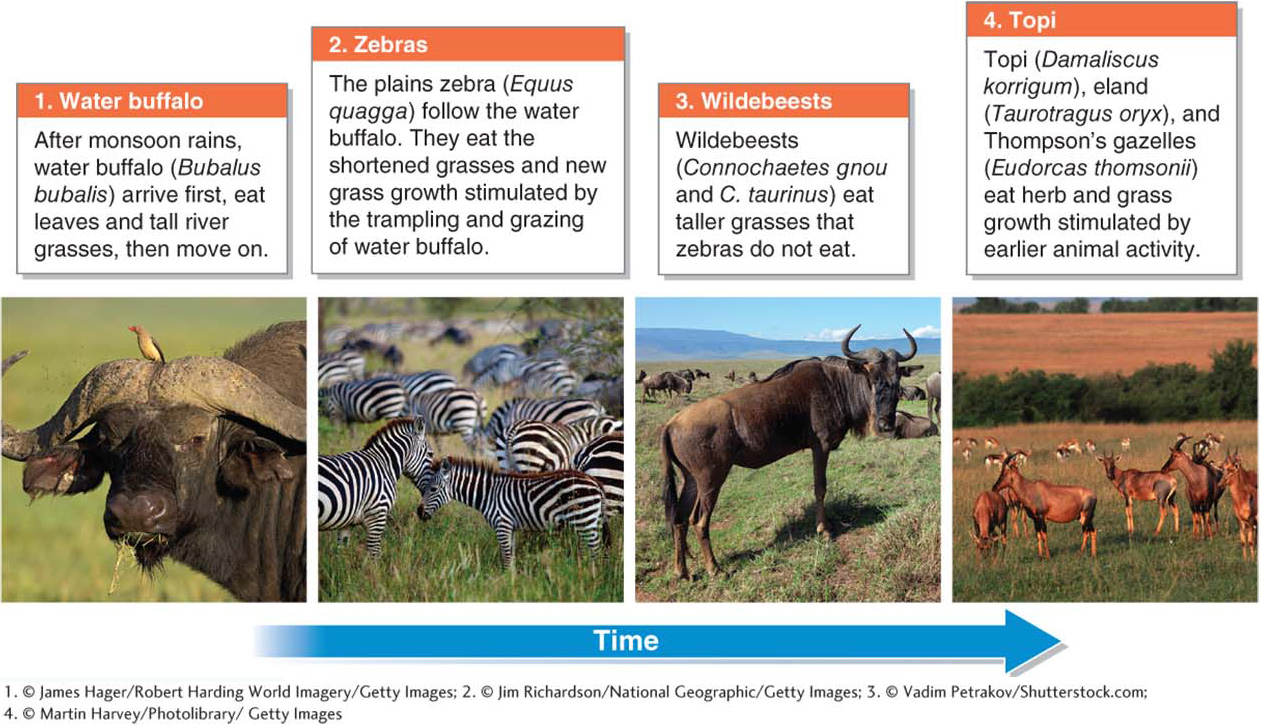
Human Footprint
One prevalent threat to the tropical savanna biome is overgrazing by livestock, particularly cattle, sheep, and goats. Increased burning by people to stimulate grass growth for livestock is also degrading savanna woodlands and threatening the habitat of native grazing ungulates. In addition, populations of these large animals have declined greatly because of hunting for trophies, elephant ivory, and rhinoceros horn (Figure 8.11). An international boycott of ivory has helped to protect elephants from illegal poaching. Many large game preserves and parks have been established throughout Africa to protect its large animals. These parks are also generating significant revenue from travelers called ecotourists, who seek to visit natural places (see Section 10.2).
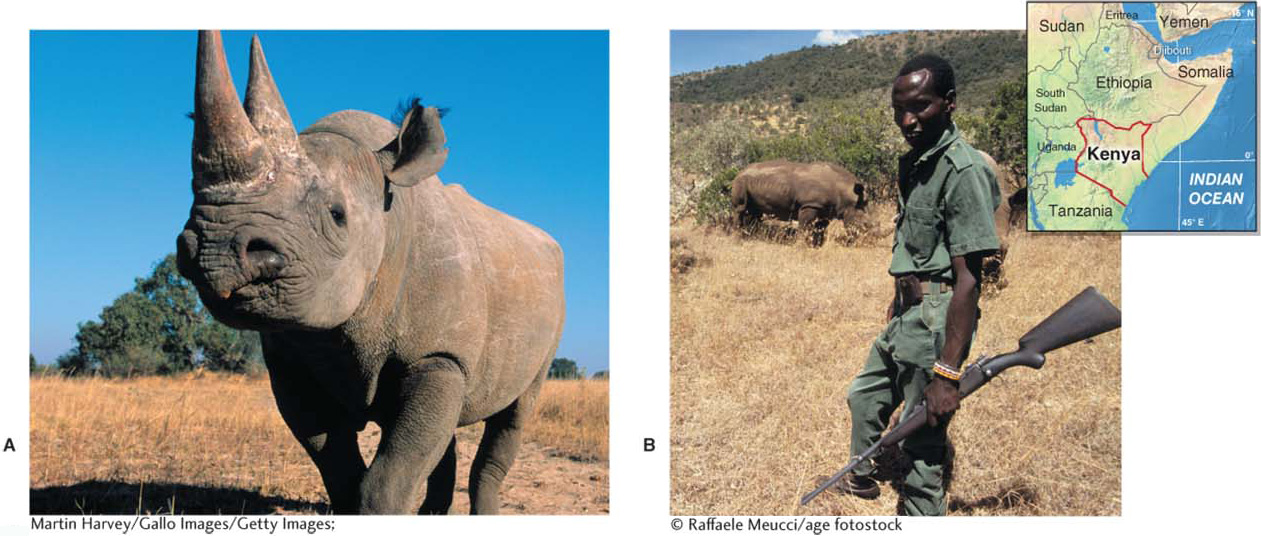
Increasingly, conflicts between African elephants and people have arisen in parts of Africa. In some cases, wildlife conservation measures have allowed elephant populations to increase. More often, however, as a result of human population growth, people have expanded their farms and villages into elephant habitat, escalating the conflicts. As a result, it is sometimes necessary to manage the elephant populations and control their numbers, as detailed in Figure 8.12.
